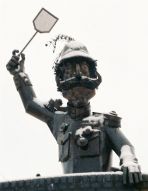
- colrehogan
- Key Master
 Offline
Offline 
- From: Granite City, IL
- Registered: 05-2-2015
- Posts: 612
Typing for long periods
Have any of you noticed yourself (hands, wrists) getting tired when typing? Is it limited to a specific machine? Is it related to your posture/position while typing? Any thoughts?
Smith Premier typewriters are cool!
- Spazmelda
- Key Master
 Offline
Offline 
- From: Ohio
- Registered: 25-2-2015
- Posts: 830
Re: Typing for long periods
Oh yes, definitely! Typing on a manual is so much different from typing on a computer keyboard. My hands definitely get tired, but not as much as they used to. The old Woodstock I have is the most tiring to type on.
- retro
- Platen Punisher
 Offline
Offline 
- From: Suffolk, England
- Registered: 11-2-2015
- Posts: 66
Re: Typing for long periods
colrehogan wrote:
Have any of you noticed yourself (hands, wrists) getting tired when typing? Is it limited to a specific machine? Is it related to your posture/position while typing? Any thoughts?
The short answer is yes, it's your position or posture. Here is the long answer  . If you are going to type for anything more than a short time then how you sit at your typewriter is very important. I learned to touch type long before computers arrived and it was drummed into us at school. Your posture will also affect speed and accuracy. In the UK girls would leave school at 15 or 16 years, having done a commercial course and get a job as a copy typist or shorthand/typist. Life in a typing pool at work meant driving an office typewriter from 9 am to 5 pm for 5 days a week. This was before the invention of RSI or repetitive strain injury so position was everything. The position of the typewriter is also important, often the machine will overlap the desk by an inch or so and this was normal. A petite teen has to get to all the controls easily and quickly and typing errors with multiple carbon copies to correct doesn't bear thinking about apart from the fact that on many forms and accountable documents errors were not permissible.
. If you are going to type for anything more than a short time then how you sit at your typewriter is very important. I learned to touch type long before computers arrived and it was drummed into us at school. Your posture will also affect speed and accuracy. In the UK girls would leave school at 15 or 16 years, having done a commercial course and get a job as a copy typist or shorthand/typist. Life in a typing pool at work meant driving an office typewriter from 9 am to 5 pm for 5 days a week. This was before the invention of RSI or repetitive strain injury so position was everything. The position of the typewriter is also important, often the machine will overlap the desk by an inch or so and this was normal. A petite teen has to get to all the controls easily and quickly and typing errors with multiple carbon copies to correct doesn't bear thinking about apart from the fact that on many forms and accountable documents errors were not permissible.
New typewriters usually came with an instruction book with instructions for the correct position for typing as did most books on learning touch typing. There are some good guides on Youtube about this and also some really bad ones. The US Navy training film is good but it was made in 1944 and does drag on a bit. It's also worth looking at some old pictures of typing pools, school typing classes and you will get the idea. You can download manuals for free on the net as well.
The typist's chair is adjustable for height and usually the back rest too. At school we each had our own chair in the typing room adjusted for each of us and our names were written on it. At home for most of us we have to make do with what is available. I normally use a writing desk and a nice comfortable chair which is adjustable for height and backrest. That's not to say I don't break all the rules and type with a portable on my lap when I am in the great outdoors for a short period but I am not as flexible as I once was.
Why not have a look at this training film
Last edited by retro (20-5-2015 15:45:30)
- malole
- Inactive Account
 Offline
Offline 
- From: East Anglia, UK
- Registered: 02-6-2014
- Posts: 330
Re: Typing for long periods
I noticed that my hands ached more after I went back to typing a lot on the laptop. In fact it got quite painful and I had to keep my sessions quite short. But on the typewriter, when typing for longer periods, I don't suffer the same discomfort. I always try to make sure I am at the right height with the typewriter, and that must be helping.
The training film is very thorough, and every time I see it I try a bit harder with my posture!
- KatLondon
- Key Master
 Offline
Offline 
- From: London
- Registered: 11-10-2014
- Posts: 995
Re: Typing for long periods
It does depend on the machine. And I have a friend who got RSI from a typewriter, back in the day, but I've also noticed that I think I get it more from computers. I hypothesise that on the typewriter you use your actual muscles more; RSI is about tendons, isn't it.
My setup here is variable and far from ergonomic, ranging from a too-high desk to a school chair/school desk arrangement, with an adjustible chair in the middle...
- Uwe
- Moderator
 Offline
Offline 
- From: Toronto, Canada
- Registered: 12-3-2013
- Posts: 4,410
Re: Typing for long periods
What many may not realize is that an ergonomically correct position for a computer keyboard is not the same as for a typewriter. I've paraphrased the following information on typewriter posture from the 1954 edition of the Pitman New Course in Typewriting.
TYPING POSTURE:
Using the correct posture is extremely important for typists; not only is it conducive to the prevention of injuries, but a proper posture also allows for better quality work with less effort and fatigue.
The following guidelines should be followed to assume a correct posture for typing (a visual reference of each point can be seen in the photo below).
1. Sit well back in your chair with the body erect but inclined slightly forward from the waist. Do not slouch over your work.
2. Place the fingers lightly on the Guide Keys*. Arch the longer fingers so that all fingers rest flush on the center of the keys.
3. The tips of the elbows should now be at the side in line with the center of the body. You may have to adjust the position of your chair with respect to the machine in order to get the elbows properly placed.
4. The forearm should slope down to the elbow when the fingers are on the Guide Keys. This slope in some measure conforms to the slope of the keyboard and, therefore, assists the typist in the reaches to the various rows.
5. The feet should be flat on the floor. If one is placed slightly in advance of the other, a better balance is maintained. The legs should not be crossed because such a position tends to throw the body out of true balance and is detrimental to accurate work.
6. The head should be inclined to the right with the eyes on the copy.Assume the positions as outlined above in order to get the "feel" of proper posture; then relax. Mental anxiety tends to induce muscle tenseness and rigidity which destroy the control and co-ordination necessary in typewriting.
*On a QWERTY keyboard, the guide keys for the left hand are the letters A, S, D, F, and for the right hand, the letters J, K, L, and ;.
The pronoun I has always been capitalized in the English language for more than 700 years.

 1 of 1
1 of 1